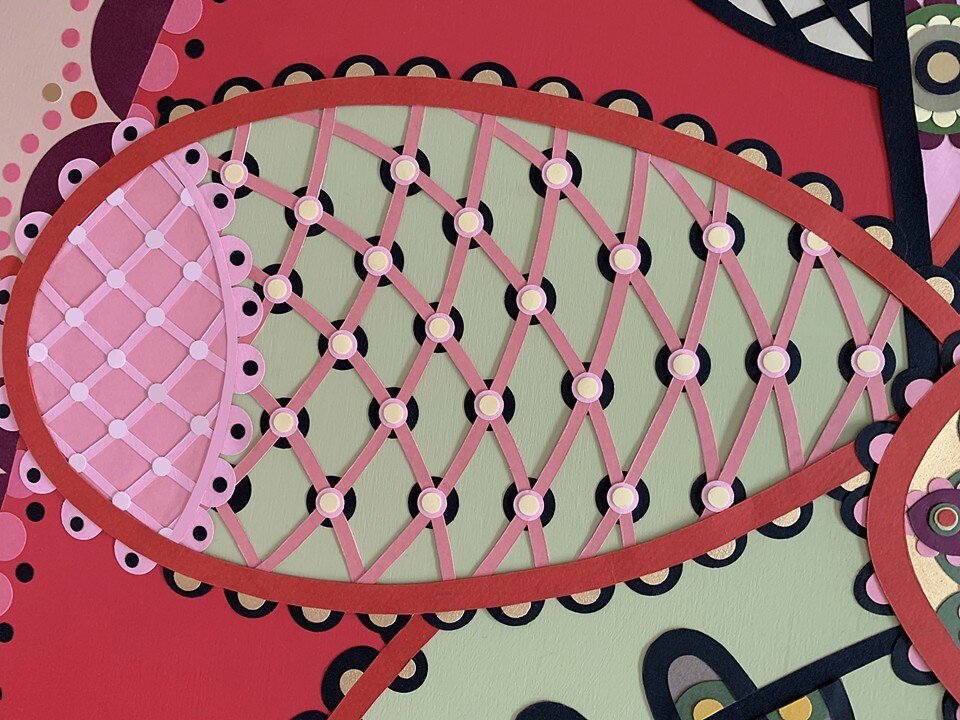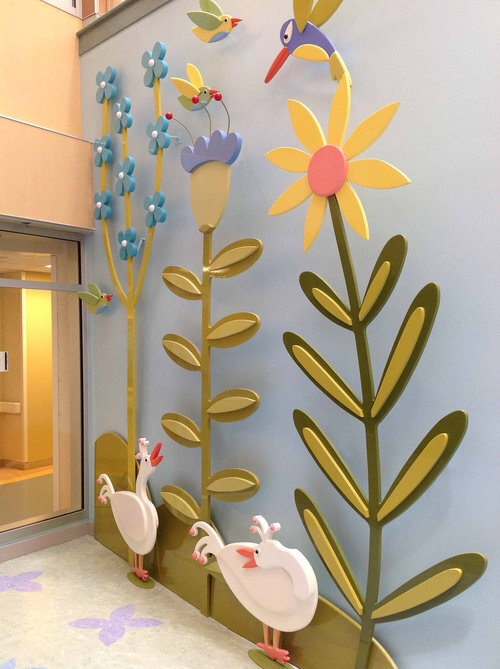Five Questions for Artist Lanie Gannon
Lanie Gannon
Five Questions
Words:
My work is in transition. I have shifted from years of making narrative sculptures out of wood to working with paper. There is a corporeal kinship between wood and paper and a natural transference of aesthetics and skills. Working with wood requires a studio filled with machines and special tools. With paper my construction method is simple and immediate. There is a practicality in working with paper; it is economical, portable, and quiet. The tools are readily available: hole punches and scissors, along with fasteners, clips, snaps, tape, glue, and paint.
My work is a diversion, a coverup, a decorative camouflage with teeth, like a bird’s plumage enticing its admirers to take a closer look.
Five Questions:
Interviews in Excellence with Artist
Lanie Gannon
String Theory, paper, acrylic paint and brads, H 8ft x W 6ft x D 4", Lanie Gannon.
1. What is your favorite piece that you have made and why?
I have a favorite sculpture, Duomo, from my days of working with wood. Part of the affection I feel for Duomo is because the meaning of the piece is clear to me. It is a response to reading I was doing at the time about the history of architecture and its relationship to craft and philosophical thinking. It sparked an interest in scaffolding as an armature for scaling buildings and as a metaphor for the skeletal structure as a protective apparatus for the human body. I was reading a book about the ancient Greeks and their civilization of artisans.* The village artisans were the most revered members of their societies, enabling the people to advance and thrive in the simplest sense. A metalsmith made utensils and vessels for eating, drinking, and carrying water. The weaver wove cloth to keep warm and wove bags to carry food. The stonemason-built shelter. The process of making led to the discovery of pattern and order, which evolved into architectural and philosophical thinking. My explanation is inelegant, but my sculpture Duomo is inspired by the early Greeks and Italians, and their remarkable engineered feats of architecture and their cultural contributions.
Duomo, wood, rope,gold leaf, acrylic paint, H60 x W17_ x D12_ Lanie Gannon.
Duomo, side view, Lanie Gannon.
2. What process do you go through in preparing for a work that you are about to make?
My projects begin with a sketchbook. I have years of them. My sketchbooks offer a timeline and documented evidence of my life. Sketchbooks are valuable resource for ideas that lead to more complete works like sculpture, painting, or installations. I scan the pages that capture my interest into the computer and use photoshop or illustrator to experiment by playing around with scale or repeats. It is conducive to acting on a whim and impulsively trying different effects. I can take a tiny thumbnail of a sketch and enlarge it while retaining the spontaneity and quality of the original line drawing. I will enlarge the drawing to the final size and print it onto the larger paper. This process helps me get started on a project. After these initial steps I can see where I am going and the pace of making a piece picks up. Intuition takes over and becomes the driving force behind the process.
babushka, sketch, Lanie Gannon.
babushka, work on paper, Lanie Gannon.
3. If you could hang your work next to any other artist’s work (past or present) whose work would it be? What piece in particular?
I would be honored if my art were worthy enough to be exhibited alongside the artist and painter Phyllis Bramson. I have admired and followed her work since the 1990’s. Years ago I had the chance to take a workshop with Phyllis at Anderson Ranch in Colorado. We created 3-dimensional drawings by transforming our sketches into art installations that we could walk through in and around. An excerpt from her web site says that Phyllis Bramson is known for “richly ornamental, excessive and decadent” paintings described as walking a tightrope between “edginess and eroticism.”
https://www.phyllisbramson.com/
https://www.instagram.com/phyllisbramson/
paper installation, Lanie Gannon.
4. Do you collaborate with other artists often? If so, how do you go about doing this?
There are a few people that I rely upon for inspiration, discussion of artistic and aesthetic questions and technical expertise. I consider this a collaboration. I met the artist Gina Binkley thirty years ago. She is an accomplished visual artist, but like all artists earning a living, she has her side gigs. One of the gigs is designing and art directing album covers and other graphics for the music business. She hired me to work on a few projects which began the initial collaboration. She is an exceptional photographer and is constantly expanding her processes and mediums to include ceramics and textiles. Our mediums are different, but our questioning is in alignment. There is a seriousness we share in our dedication to making art. We are both industrious and work hard at finding ways to survive financially, yet always within the sphere of our artistic practice. Our opinions and advice to each other about our work and consequently life is honest with a heavy dose of encouragement.
https://www.ginabinkleybyhand.com/
https://ginabinkley.com/
https://www.instagram.com/ginabinkleyceramicworks/
queeny, Lanie Gannon.
queeny, detail, Lanie Gannon.
5. How do you manage all of the other stuff artists have to do, besides the artwork? Do you have a particular system for this?
It is not easy to separate an artist’s life into separate compartments, such as work and play. As if it is your art practice versus everything else. Most of the daily living goes on beyond the studio walls. Especially if you have arrived at a point in your life when responsibility for other people is paramount. Being an artist has never been a profession that a person pursues for money and security. I think it is a precarious profession of “just barely getting by” financially. With all the side hustles, day jobs, and gigs I have had throughout my working life, most of them have related to art. Artist originated the gig economy and we have many skills that transfer into other creative marketplaces. I think it helps to be focused, resilient, and even scrappy. I have cleaned hourly motel rooms, painted houses, built and painted sets for events, designed and illustrated album covers, textiles and clothes, waited tables, taught for twenty years at a university, and conducted workshops. Throughout, I kept my focus on getting back to the studio to make my art. There have been lots of things I wanted, too, but could not afford. I became resourceful. I made my own clothes. We found a house that was dilapidated, and my partner and I renovated it. We designed and built most everything in our house. We learned to repair our cars and appliances. If it was something we wanted, we had to make it.
And One More:
Do you have any advice to give artists that you would like to share?
(since I’ve been at it for so long!) On Mondays, I tend to email and paperwork, bill paying, phone calls, appointments, and general office work. It is important to file your taxes and especially pay into Social Security. It is unbelievable how fast life will progress and you will need it. Do not use the excuse that Social Security will not exist in the future. It will be a lifesaver for you as an older artist. Pay it. Make sure you buy medical insurance, too.
Take advantage of https://www.healthcare.gov. It will relieve some of your stress. Learn Photoshop, InDesign and Illustrator and all the other programs necessary for your work.
I have spent most of my art career getting rejected from every application submitted. I have kept a file filled with rejections from grants, fellowships, exhibitions, competitions, galleries, and residencies. It is difficult at first to accept the sting of rejection. At this point in my life, it hardly means a thing. I am so accustomed to rejection that I keep trying for more! I think an unwritten rule in being an artist is that you must evolve. Growth with your work is paramount. If you are at all like me, you will find that you feel your best when you are immersed in a creative project. This could be the key to it all!
Nero, suspended and assembled paper, Lanie Gannon.
* McEwen, Indra Kagis. Socrates’ Ancestor An Essay on Architecture Beginnings 3rd ed., Cambridge MA, MIT Press, 1993.
Public Works of Art
https://laniegannonpublicart.com/













